Visiting the leather tanneries was one of my main reasons for wanting to go to Fez in Morocco
But, I’d gone right off the idea by the time I’d read other travellers’ experiences on websites such as TripAdvisor…
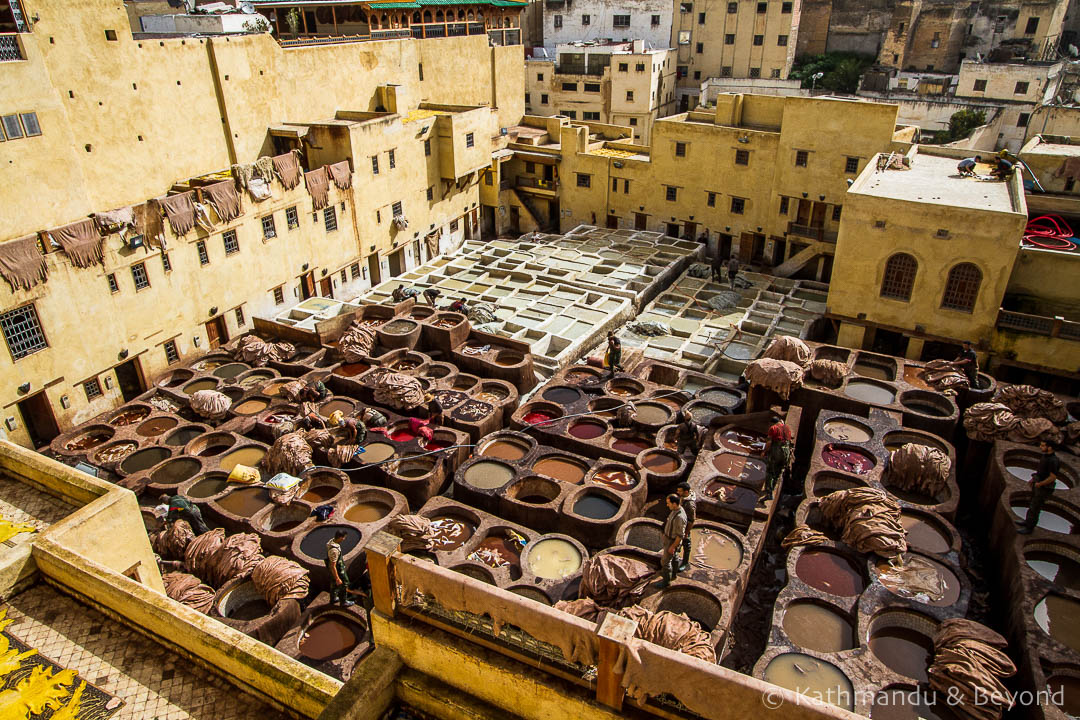 Chouara (Chaouwara) Leather Tanneries in Fez Medina
Chouara (Chaouwara) Leather Tanneries in Fez Medina
I already knew that to get the best view of the tanneries, I would have to enter one of the many leather stores that surrounded them. There are large viewing terraces that look down onto the pits but, to get to them it is necessary to pass through cavernous shops stacked floor to ceiling with all manner and every colour of leather goods from shoes and sandals to tiny purses to huge holdalls.
Although officially it is free to view the tanneries, there is no such thing as a free look and the shopkeepers, whose premises you have to access to do so, have a reputation for being rather aggressive salesmen.
To be honest, I wasn’t expecting to get away with anything less than feigning a little interest. But surely it couldn’t be any harder to say no to a shoe seller in Morocco than it is to a carpet seller in India or a tuk-tuk driver in Indonesia?
After a few minutes browsing TripAdvisor, I’d read some horror stories from tourists claiming that, after refusing to buy anything, they’d been held hostage until they handed over a hefty ‘tip’ for the privilege of visiting the viewing terrace. I was expecting to hand over a few dirhams but what I read made the entire experience sound dreadful. Reading on I learnt that the stench from the tanneries was so bad people were gagging or almost passing out. Visitors were handed sprigs of mint to protect their delicate noses. Assuming this was a kind gesture, many later discovered a price tag attached to that little bundle of sweet-smelling leaves!
With slight trepidation but undeterred, we set off in search of the tanneries.
There are a few leather tanneries in and around Fez but the largest and best-known is Chouara Tannery in the heart of the souk. While wandering through the labyrinthine alleyways on previous days, many “helpful” Moroccans had offered to take us to a tannery. Wary of a scam, I tried to pinpoint the location on my phone’s maps.me app. I don’t know why I hadn’t learnt from previous attempts to follow GPS coordinates in a Moroccan souk – it seems all the narrow streets and dead ends haven’t yet been fully mapped out. I need not have worried about finding Chouara however; wall signs and the smell led us in the right direction!
Partly in anticipation of the hassle involved, Mark was never that bothered about seeing the tanneries in Fez and almost didn’t come with me. In the end, he did – perhaps he thought he would protect me from aggressively persistent shopkeepers!
We went early in the morning, before most of the touts had got out of bed, and managed to get ourselves to the tanneries without too many wrong turns. The shopkeepers don’t miss a trick though and were already open for business. We walked past a couple of shops, not knowing how to spot a proprietor who wasn’t going to scam us and approached a doorway with a set of narrow stairs leading up. “Come, come,” was the welcome cry. “Yes, come to my terrace where you have a very good view for free…”. “I don’t want to buy anything,” I pre-empted. “No problem, no problem,” came the response.
At this point, Mark must have decided that I didn’t need protecting and chose to wait outside for me, uncomfortable with the thought of having handbag after handbag paraded past him. I followed the guy up the stairs, past walls lined with bags and shoes. Knowing that I would have to give a tip, and not wanting any nasty surprises, I pressed the question: “How much to go to the terrace?” Once again, he assured me it was free. Or, “Whatever I wanted.” Fine. Based on my research of what was reasonable, I had a figure of 5 dirhams (around 40p/ 50 US cents) in my head so that’s what I would hand over on my departure and hold my ground.
But first to the viewing terrace. Fez’s leather tanneries have fascinated me for a long time. I don’t know why, but I suspect it’s because they appear so photogenic – rows of over-sized painters’ palettes full of deep earthy tones, glistening under the Moroccan sun.
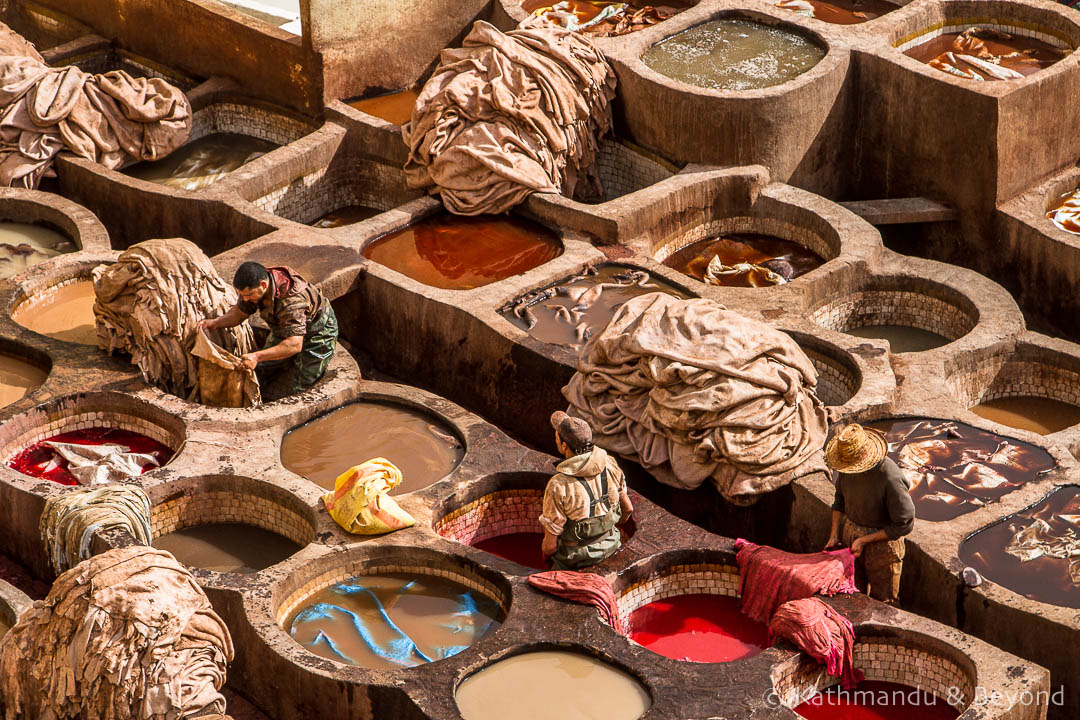 Men at work in the dying vats
Men at work in the dying vats
I held my breath (in anticipation of the smell, not the excitement!), stepped outside and looked down. The smell wasn’t as bad as everything I’d read. It wasn’t pleasant but it wasn’t the worst I’d encountered. Maybe that says more about the kind of places we travel to! But thankfully the sight of the pits below did live up to expectation. As I looked around I could see the hides (goat, sheep, cow, camel) in various stages of the process. There were two different kinds of vat: the skins are first put in the white ones which contain a mixture of water, limestone, and pigeon droppings. Yes, pigeon droppings! Apparently, pigeon poo contains ammonia (which accounts for the odour along with the wet animal skins) that softens the hides whilst the limestone helps to remove the hair.
After a few days, the skins are washed and transferred to the brown dyeing vats to be coloured using natural products: cedar wood (brown), poppy flower (red), indigo (blue), henna (orange), mint (green), and saffron (yellow). Saffron is costly, so this dye is applied sparingly to individual skins which are then laid out to dry in the sun. After the guy told me this and other interesting facts about the process, he left me to take my photographs.
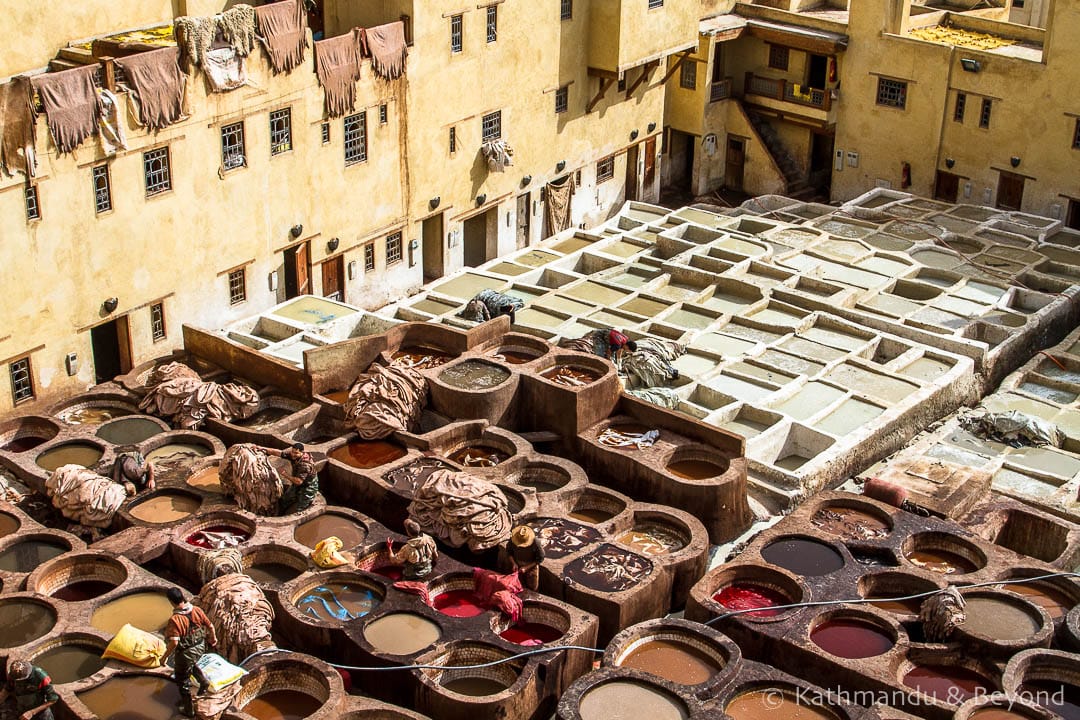 The square white vats are for preparing the skins and the round brown ones are dying vats
The square white vats are for preparing the skins and the round brown ones are dying vats
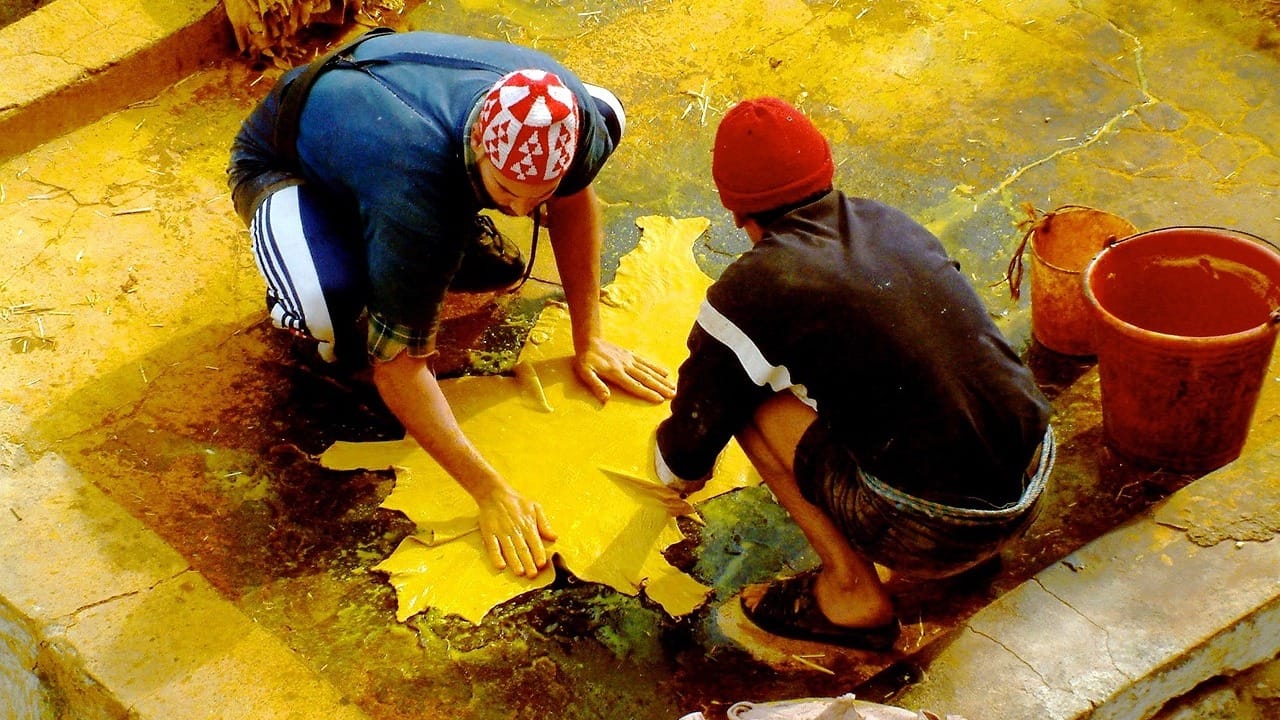 Applying yellow saffron colouring to the hides
Applying yellow saffron colouring to the hides
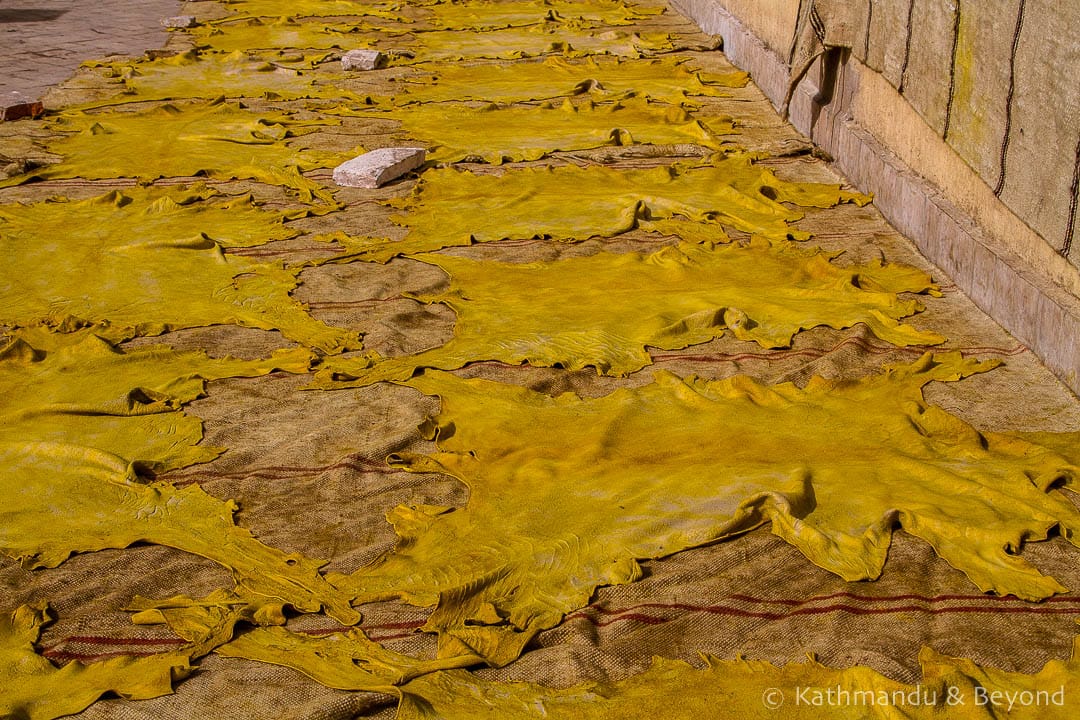 Saffron-dyed hides drying in the sun
Saffron-dyed hides drying in the sun
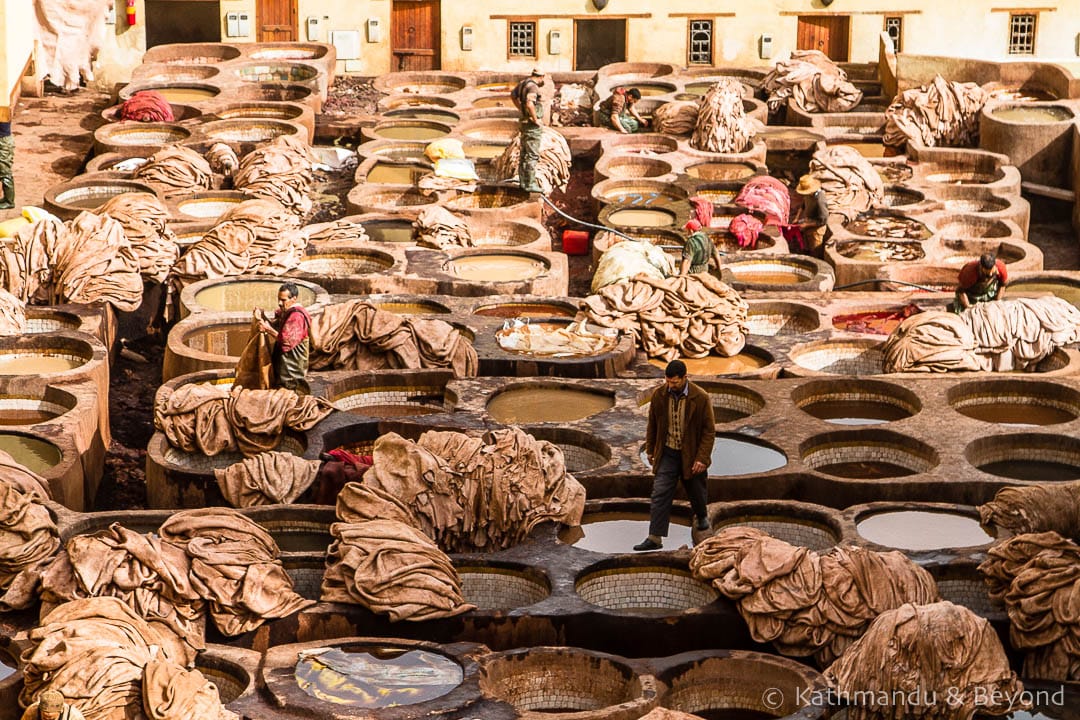
I was ready to leave but wasn’t expecting to get away without cooing over at least one handbag. Yet, as I wandered down through two floors packed to the rafters with leather goods, I didn’t get so much as a: “Would you like to look?”, let alone a hard sell. I kept waiting for one, but it didn’t come and there appeared there wasn’t a catch. At the door, I thanked him and handed over a 5 dirham coin which he received with thanks.
And that was it. I was out, unscathed, unharassed and with a camera full of photos that Mark was going to be happy with!
Whilst I had a good view of the pits, I felt it could be improved and so when a few doors down, another shopkeeper invited us to his terrace for just one dirham each, I couldn’t resist. Initially, Mark followed but soon, perhaps freaked out by the number of shoes and handbags on display, thought better of it and turned back. “He still needs to pay,” the guy said. “No problem”. Two dirhams wasn’t going to break the bank. Once again, I was free to wander around the terraces and take my photos unhassled. It was inevitable, that as I passed through the shop to leave, the guy encouraged me to look at the wares. I began to explain that I didn’t have any room in my backpack for shopping, or indeed a home to furnish but of course, “There’s always room for a small purse, madam…”. I smiled and walked on. There was a Chinese couple deliberating over some pointy-toed slippers, who were probably a better focus of his salesmanship than me so I managed to slip away, after handing over the equivalent of 15 pence as a gratuity.
After leaving the second shop we wandered down an alleyway leading towards the pits themselves and a donkey laden with animal skins passed us.
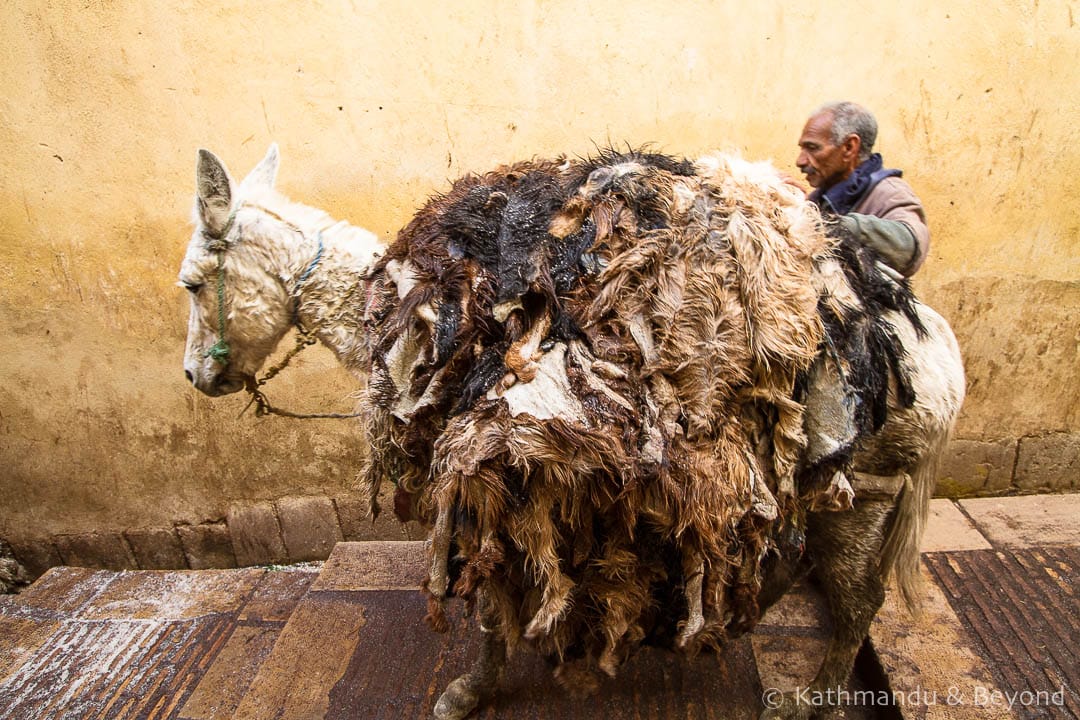
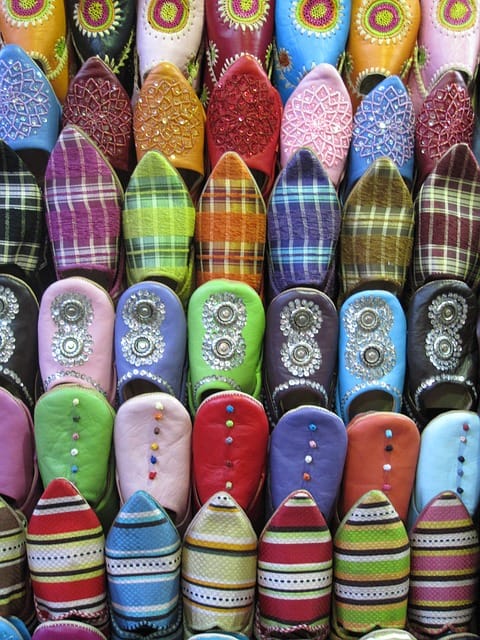
(above) From this… to these
Having seen the pits from above, I was keen to get a closer look, and Mark liked this idea too. At the entrance, a guy with an official-looking pass around his neck said we could go in, but the price was 20 dirham each (US$2). We hesitated; mainly because we knew what holding back does to the price in this part of the world. “OK, 10 each,” he offered. Deal.
So in we went where we were able to walk around freely. We wove between the workers as they continued their work without paying much attention to a couple of tourists with a camera. It was interesting seeing the process at close quarters and it also gave us the opportunity to peek into some of the small side rooms that can’t be seen from above. Looking up, we could see a particularly large terrace with a lot of tourists – clearly the spot where all the tour groups are taken and undoubtedly given a harder sell than I was! As they peered down, snapping their photos, they were probably also wondering how we had managed to get where we were! Dodging the worker’s knives as they deftly prepared the newly arrived hides, avoiding splashes of terracotta-coloured dye as they were manually swirled around the vats. Even Mark had to admit that he’d enjoyed visiting the tanneries (or was it that he felt we had got one up on the tour groups!?).
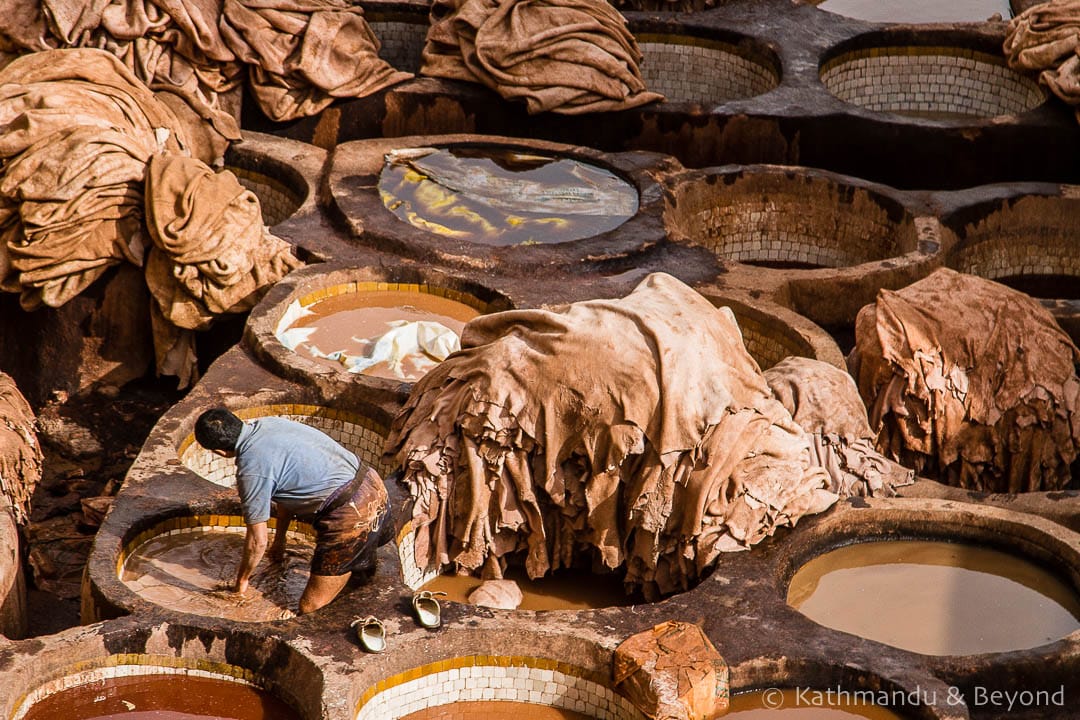
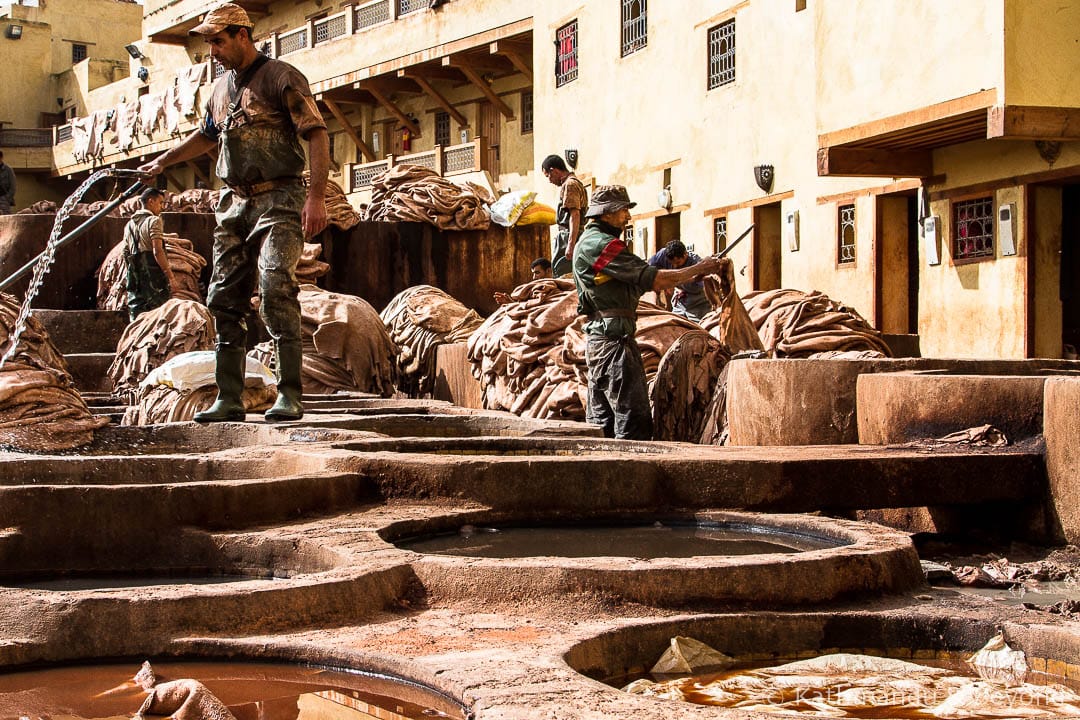
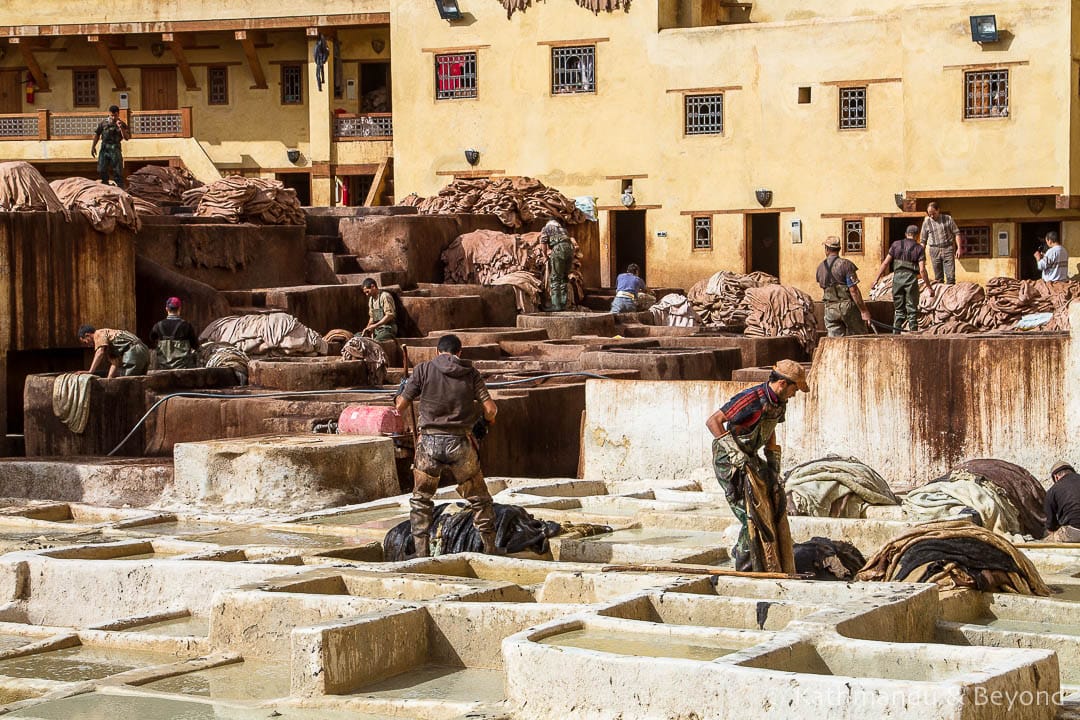
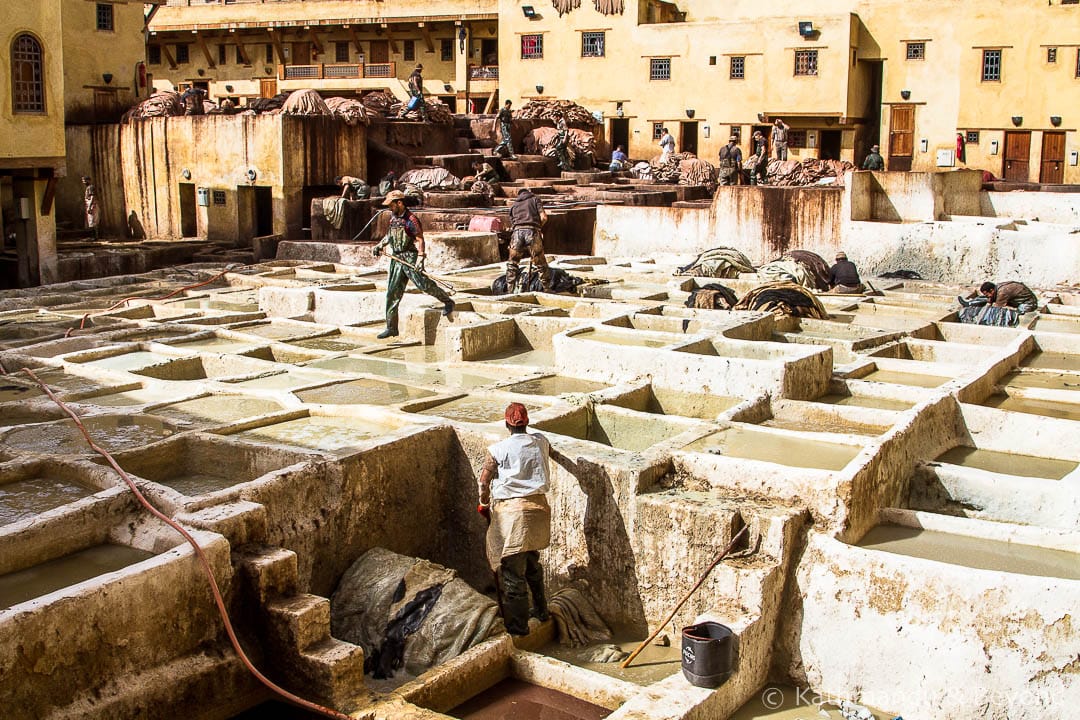
Our experience of Fez’s leather tanneries wasn’t as traumatic as the internet had led me to believe. It wasn’t traumatic at all and the pressure to buy, or even hand over a lot of (if any) money to view the tanneries was so absent it led me to think that the local authorities had warned shopkeepers against aggressive behaviour towards tourists as it was damaging the destination’s reputation.
My advice? Don’t be unduly daunted by a visit to the tanneries: go with your wits about you, a smile on your face and a firm but polite tone in your voice, if you don’t want to shop! Carry some small change, and, don’t forget your camera and a sprig of mint!
ARE YOU PLANNING A VISIT TO THE LEATHER TANNERIES IN FEZ? OR HAVE YOU BEEN? PIN THIS POST FOR LATER…
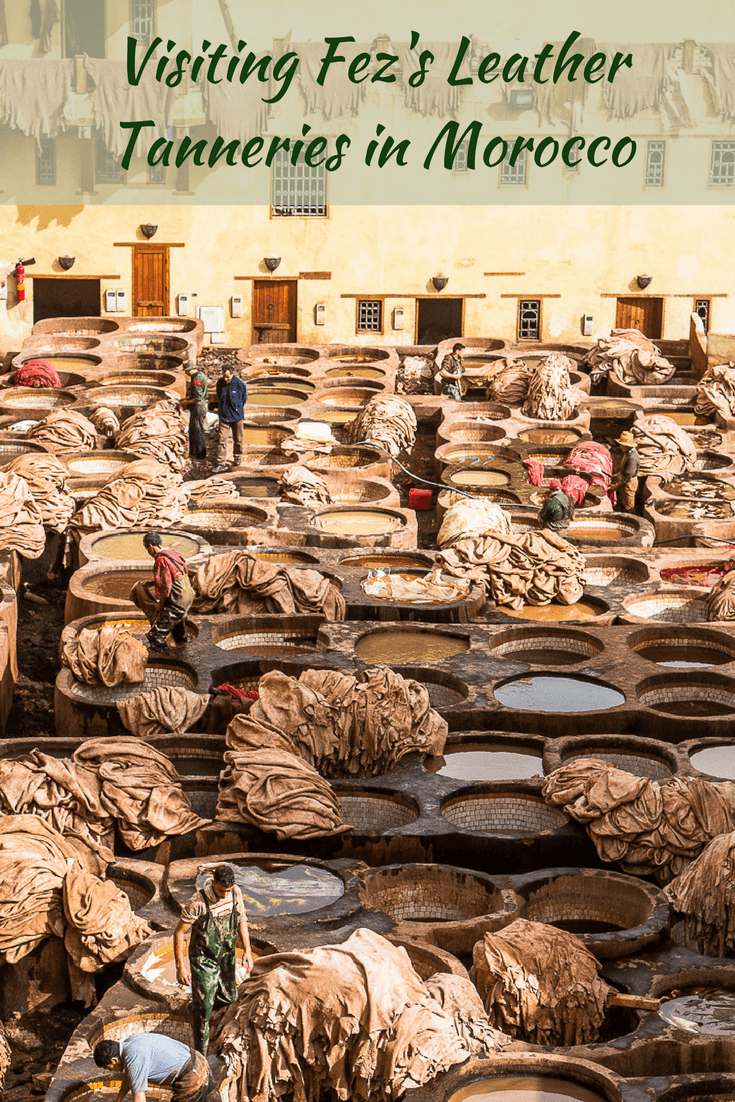
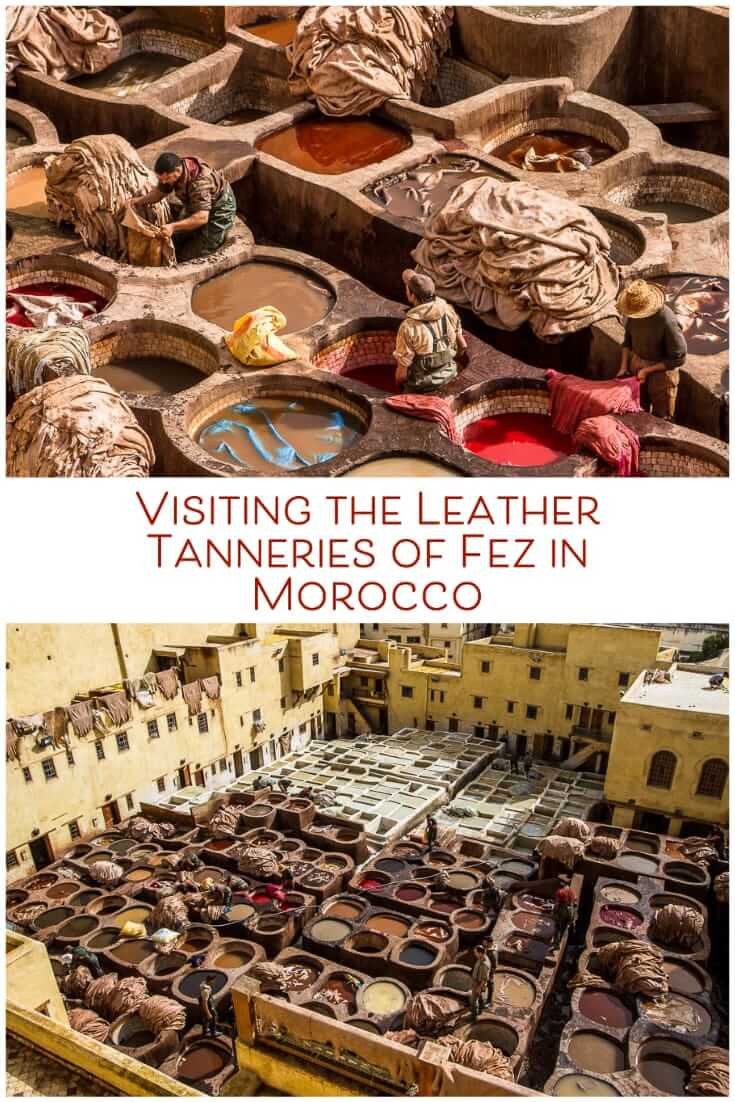
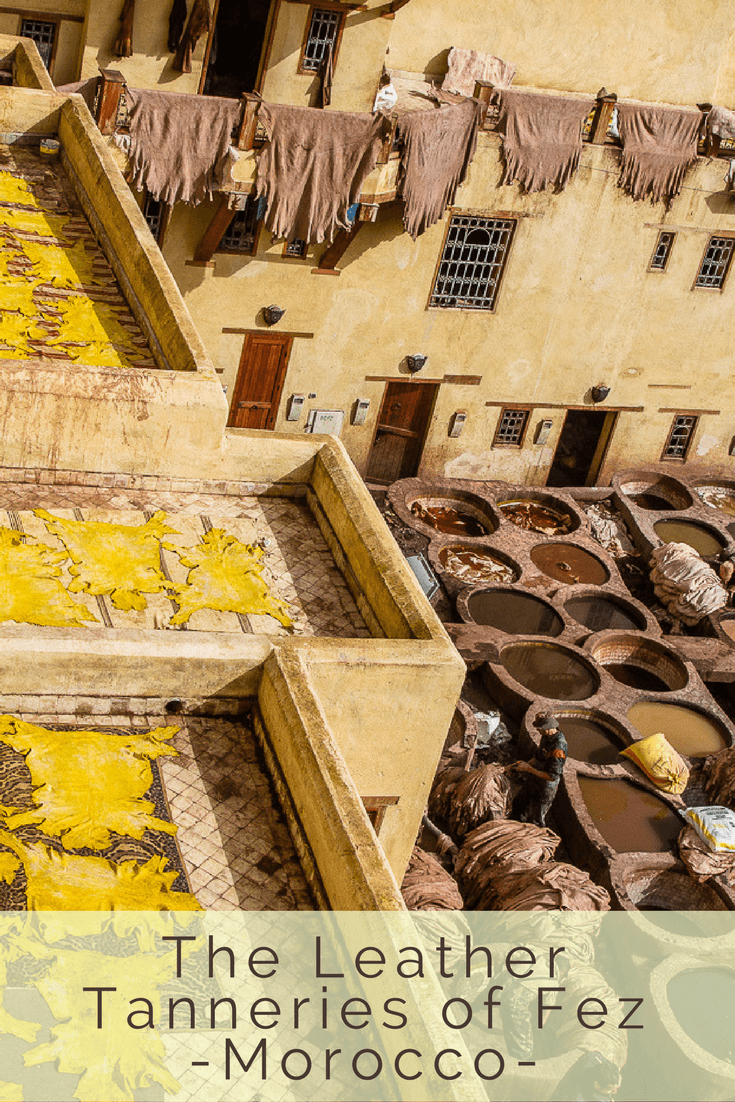

Really enjoyed this piece. A great place to visit, good photos and some tips on avoiding hassle.
Thank you! Happy you enjoyed it! 🙂
That was very interesting. Great photos, as always.
Thanks Doug, glad you enjoyed it! 🙂
When reading traveller’s blogs one often wonders how two people can have such different experiences / views on the same place. So I’m a bit wary when I read about places I know / I’ve been to. Glad to see that, as is most often the case with you guys, we have a similar view on this place too 😀 Looking forward to traveling with you again someday…
Thank you. But I also think that is the beauty of travelling and exploring different cultures – we all see things from a different perspective!
So cool! Would love to visit some tanneries as well some day. I’ve read a lot about the smell as well and I’m glad to read it isn’t as bad as everyone is saying. We’ve been to Rotorua, New Zealand, last year, and it’s a little smelly there too, so I guess we would survive the tanneries too. 😉 Great photos!
Thank you! Yes, I think you’d survive – the smell at the tanneries wasn’t as bad as that horrible eggy sulphur pong can be! 😉
Hey Kirsty,
Thanks for this post. My wife and I are going to Morocco soon and doing some research. The tanneries look like a lovely thing to do but I’ve heard of so many hassles in Fez. I wanted to know about your experience in the city aside from the tanneries. Any advice you have or troubles you ran into? I’d love to have a great experience.
Thanks,
Hi Anthony,
Glad you enjoyed the post. Well, I suppose ‘hassles’ are all relative – Mark almost didn’t want to go back because of the hassles he experienced as a young, inexperienced traveller, but 25 years it didn’t seem so bad – I reflect on this in an upcoming post!
We didn’t have any problems in Fez, or anywhere else in Morocco, but the touts seem to pop up on a more regular basis in Fez! You will receive offers of assistance seemingly on almost every corner but hard as it may be to distrust a friendly advance or rude as it may feel to ignore them, bear in mind that they almost certainly have an ulterior motive if you do engage in conversation, you could end up in a shop you don’t want to be in, or lost in a souk! An open mind is important when you travel, but Morocco is somewhere you shouldn’t be afraid to stay firm and say no!
When and where are you travelling to in Morocco? If we can help further, do let me know! Otherwise, happy travels. Morocco is a very colourful country! 🙂
Fantastic post! Really felt like I was at the tanneries too. Enjoyed reading it, congratulations on a great post and photos!
Thank you! So happy you enjoyed the post
It is a very advantageous post for me. I’ve enjoyed reading the post. Thanks a lot for this beauty Enjoying article with me. I appreciate it very much!
Glad you enjoyed the post! 😉
5 Dirhams? really ? Would you give that to someone serving you where you come from? Cheap!!
Two things to note here… firstly, no I probably wouldn’t give the equivalent of that amount as a tip for someone serving me in my country. But a tip should be in proportion to the cost of living, based on a percentage. Therefore that amount will be different – 10% of the cost of a meal in London, will be a very different amount to 10% of the cost of a meal in Fez. Secondly, the five dirhams wasn’t in relation to someone “serving” me. There was no service provided and so I don’t really understand your statement!
Hi
May I know the number of Chouara Tannery store did you go to?
Unfortunately, I didn’t make a note of it. I wish I had though!
Thank you. After reading your story on the tannery I got a taxi there and have just spent 3 hours enthralled by the sights, sounds and the smell. I walked around the bottom with a guide. At all times I felt comfortable and welcomed, All this for no charge, and no pressure to buy. I will remember this visit always, with love.
Fantastic! Happy to hear you had a good experience at the tanneries. You’re right – the smell is definitely something that you don’t forget in a hurry! 🙂